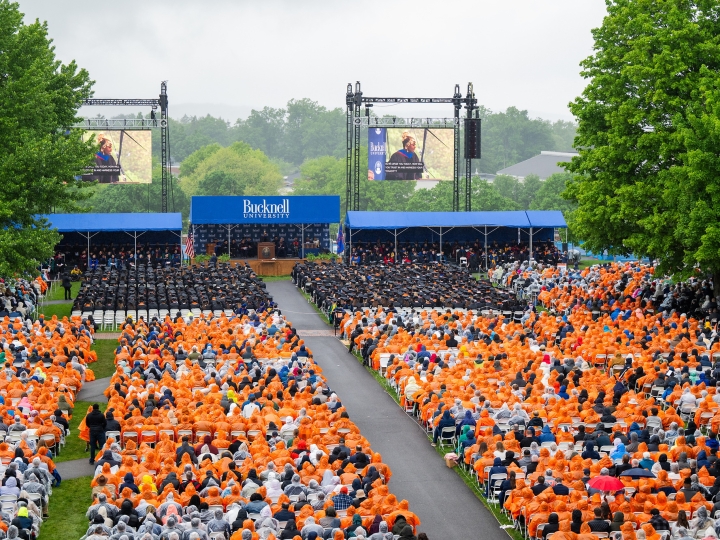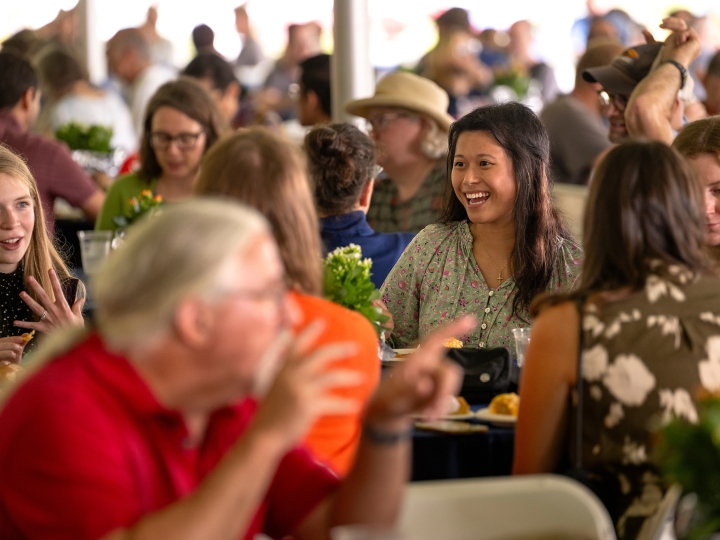
Across Time: Special Collections/University Archives presents a tangible history of an institution and much more.
January 1, 2016
From all the treasures in the Special Collections/University Archives, Bucknell magazine editors chose their 10 favorites from the collection.
Early editions of William Butler Yeats, along with businesslike letters from the poet's sisters. World War II propaganda posters. A nearly complete collection of works by contemporary book artist Werner Pfeiffer. Photos of covered bridges. These are just a few of the eclectic objects sprinkled throughout Bucknell's Special Collections/University Archives.
This spring, Bucknell Magazine editors Sherri Kimmel and Matt Hughes paid a visit to Isabella O'Neill's neat, elegantly woody environ on the lower level of the Ellen Clarke Bertrand Library. From all the treasures the University archivist revealed in the LaFayette Butler Reading Room, the editors chose their 10 favorites from a collection that includes 10,000 rare books tucked away behind the scenes in a back room.
Admittedly, it's a "very broad collection," as O'Neill puts it, with many items donated by alumni or others interested in Bucknell. Some works are specially purchased, often in consultation with faculty, through the generosity of the James A. Russell Memorial Book Fund, the Friends of the Library and a small departmental budget to support the curricular purpose of the Special Collections/University Archives.
O'Neill keeps an eye on acquisitions that support classics & ancient Mediterranean studies, for instance. "We need more Virgil and Homer texts," she notes. She also seeks supplements to the manuscript-leaf collection, which are used by Professor Janice Mann, art history, and other faculty, and the print-study collection that was developed with input from Mann's colleague Christiane Andersson, who uses works in some of her classes. "Students get to see the real thing," O'Neill says of the colorful illuminations from the medieval books of hours.
"Undergraduate institution collections are made to be used," she observes. "At a larger institution, the collection is not always as accessible. Our students respect the material and get a lot out of it by coming in here."
1. Books from the Press of Appletree Alley
Some retired men spend their days in the garage, tinkering with a classic car or motorcycle. When graphic designer and public relations practitioner Barnard Taylor retired in 1979, he chose to tinker with a Vandercook No. 4 letterpress.

Taylor founded The Press of Appletree Alley, named for the setting of his garage-turned-print-shop, to produce beautifully printed limited editions of fine writings, poetry, prose and letters from 1981 to 2002. He collaborated with Bucknell writers, including Professor of English Jack Wheatcroft '49 and several poets-in-residence, to create many of the press' more than 30 titles, which were typeset and bound by hand, and frequently illustrated with linoleum-cut prints. Bertrand Library owns a complete collection of Appletree Alley limited editions, as well as a manuscript collection detailing the business of making each fine edition.
2. The Burma-Bucknell Bowl
What's that silver bowl, so shiny and intricately carved, sitting on a shelf in Special Collections/University Archives? It's a gift from Burma to Bucknell commemorating 100 years of friendship. The bond between the nation now known as Myanmar and the University began more than 150 years ago when Baptist minister and Bucknell trustee Eugene Kincaid encouraged Maung Shaw Loo, Class of 1864, to become the first international student at what was then called the University at Lewisburg.

The silver bowl is embossed with motifs of contemplation, peace and tranquility. And its hand-carved stained teakwood stand is supported by three half-lion, half-dog "protectors" of the bowl.
Each spring the Burma-Bucknell Award is given to a community member or organization for outstanding contributions to intercultural and international understanding within the University community. Recipients are given a replica of the original bowl, which was presented to the University by the president of Burma in 1958. This year's recipients were Professor Angèle Kingué, French & Francophone studies, and Mona Mohammed '16.
3. Leaf from a French Book of Hours
Medieval mourners bring out their dead in this illuminated page (or leaf) from a 15th-century French book of hours. The page provides an ominous opening for the Office of the Dead, one of the prayer cycles typically contained within a book of hours. The books were the most popular religious tomes of medieval Europe and contained prayers, psalms and readings for Christian devotion. They were often illuminated, and the more expensive volumes were lavishly embellished and personalized for their owners. This page dates to around 1440 and is probably from eastern France.

Surrounded by an intricately interwoven border of burnished-gold ivy leaves and colorful flowers, the page depicts a funeral mass, with priests, singers in choir stalls and black-clad mourners bearing candles. In the corner, a bearded grotesque figure rides backward on a beast and raises a club, perhaps preparing to rain down eternal punishment.
Special Collections/University Archives owns leaves from books of hours from the 13th through the 16th centuries, which are frequently studied by English and art history students as well as others.
4. The University Charter
In 1846, a 55-year old teacher and acting president named Stephen Taylor neatly wrote out on parchment a charter for a new university, which would be renamed Bucknell in 1886. The small committee of men who'd recruited the veteran educator to lead the new University at Lewisburg funded his trip to Pennsylvania's capital, Harrisburg, and asked him to stay until the state legislature approved the new charter.

Lewis Edwin Theiss, writing in his Centennial History of Bucknell University, 1846-1945, describes the process: "In exactly 17 days after the first reading of the charter, the legislature had passed it, without changing a word, and Gov. Francis Shunk signed it. Thus on Feb. 5, 1846, the college in a certain sense was born."
For many years, the original charter was displayed in the President's Office. It was transferred to the University Archives collection in 2012 and conserved. A facsimile of the original charter was made and now hangs in the Traditional Reading Room of Bertrand Library for all to view.
5. Stakes Used in Early Groundbreaking Ceremony
Soon after the Rev. John Howard Harris became Bucknell's president in 1889, he tasked William Gretzinger, Class of 1889, with leading the University's publicity efforts. Gretzinger, who within a year of graduation also was named the University's first registrar, began an unprecedented advertising campaign that included catalogs and pamphlets; paid advertisements in newspapers, prep-school publications and religious periodicals; and a news service.

The effort rapidly paid off. Enrollment nearly doubled within a decade, rising from 285 students in the 1889–90 academic year to 487 in 1899–1900, but the influx created a demand for housing as well as classroom space and teachers.
Bucknell broke ground April 3, 1899, on a building that could accommodate its growing student body: a living space for 100 men that would, until 1959, be known as West College and, thereafter, Kress Hall.
These four wooden stakes, representing the first-year through senior classes, with satin ribbons corresponding to the class colors, were driven into the ground with a wooden mallet at West College's groundbreaking.
6. John Gould's Birds of Europe
You might know the English nonsense poet Edward Lear for his famous work about the owl and the pussycat, who went to sea in a beautiful pea-green boat, but did you know that Lear drew owls, eagles and pelicans too?

As a young and nearly starving artist in the 1830s, Lear partnered with English naturalist John Gould to use the then-novel process of lithography printing to create colorful bird prints. Lear trained Gould's wife, Elizabeth, in lithography as well, and in 1837, they published their most ambitious work up to that time: a five-volume set of ornithological descriptions containing 448 hand-colored lithograph plates depicting the creatures inhabiting Europe's skies. Most were illustrated by Elizabeth, but the most dramatic, including the owls, were done by Lear.
Bucknell's copy of Birds of Europe, a gift from Hollis Ross '28, might have belonged to the most famous bird illustrator of all, John J. Audubon. The books' green-leather front covers are engraved in gold "Audubon FRS" (possibly standing for Fellow, Royal Society).
7. David Jayne Hill's Scrapbook of the Renowned
In 1898, concerned by the advance of ever-more-horrific weapons technology, Czar Nicholas the Second of Russia called for a grand meeting of the leaders of the 19th century at The Hague, Netherlands, to discuss disarmament, the laws of war and war crimes. The group met again in 1907, with U.S. Ambassador to the Netherlands and former Bucknell President David Jayne Hill, Class of 1874, M'1877, among the U.S. delegates to the Second Peace Conference of The Hague.

Hill left the conference with a fine souvenir: A one-of-a-kind commemorative book whose autographed pages are a who's who of prewar aristocrats, diplomats and industrial titans. Kaiser Wilhelm of Germany and Czar Nicholas, who in a few years would send armies to tear each other apart, share space with King Edward the Seventh of England, steel magnate Andrew Carnegie and President Teddy Roosevelt. The signature of each is beautifully adorned with hand-drawn illustrations believed to have been commissioned by Hill's wife Juliet.
Perhaps the most intriguing illustration in the book, though, is this original ink-wash portrait by John Singer Sargent (pictured above), which reflects the pressure of international diplomacy.
8. World War I Memorabilia
It's been a century since more than 650 Bucknell students, alumni and faculty served the Allied cause in World War I. Special Collections/University Archives commemorates the University's doughboys by displaying several personal items. One is a croix de guerre, a French military decoration awarded to Harold Thomas '21. A citation depicting Thomas' actions in war-torn France reads that he "displayed an absolute zeal under ;all circumstances. During the period from Aug. 1–6, he kept up a service of evacuation in a zone subject to violent bombardment."

Thomas also contributed another interesting World War I relic: a gold cigarette lighter with an engraved image of a French soldier on one side and an American one on the other. It's an intriguing example of trench art, crafted by soldiers while they passed the time between battles.
9. Containers From the Bucknell Dairy Farm
The crunch of green grass being contentedly chewed, the swish of a tail and a low-pitched moo. Those are all comforting sounds the typical Bucknell student could enjoy in the 1920s through the 1960s. Long before the local foods movement, students dining on campus sipped milk supplied by black-and-white Bucknell cows, denizens of the University Farm.

While cows grazed on the green slopes across Route 15 next to the dairy operation, housed in what is now the Art Barn, students used the facilities for practical study. Courses in bacteriology and sanitary science were among those offered. In the 1920s, the biology department even held a summer course in sanitary milk control.
Today Special Collections/University Archives displays a Bucknell-embossed copper milk can and glass bottle once used to contain this homegrown moo brew.
10. Women's Gym Suit

Teal is a popular color these days. Who knew it was also a winner back in 1866? Louise Neubecker, Class of 1866, of the University Female Institute found out when she enrolled in the school for women, which was administered by the University from 1857 to 1917. Back in Louise's day, students received detailed instructions on how to sew their gym suits before arriving at the Institute. Louise's suit remains in excellent form as Michelle Choe '18 of the student fashion magazine Be Fashion demonstrates.

